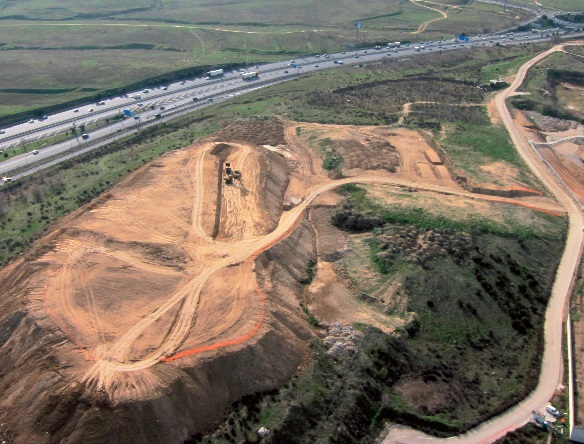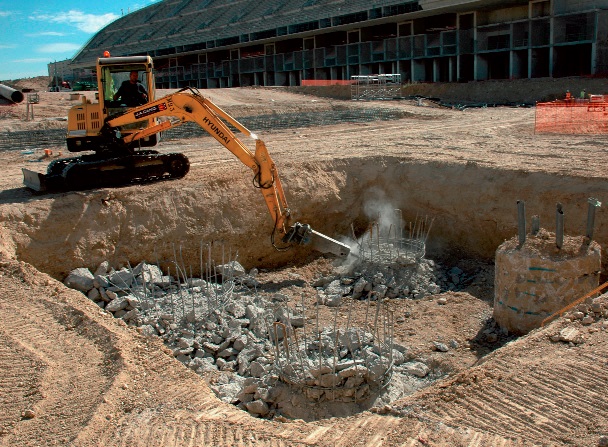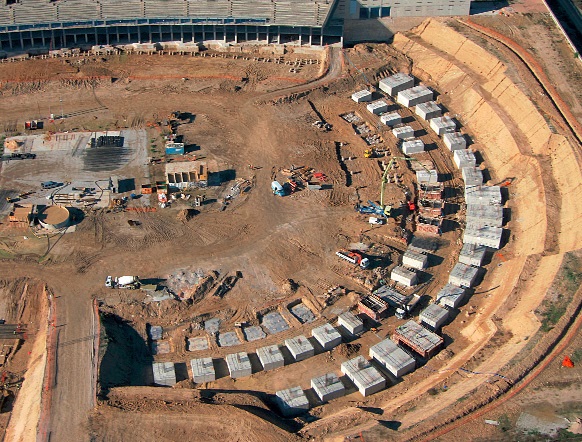Atletico Madrid's new stadium
Description of the Environmental Measure
Problem detected:
The enlargement and refurbishment of the Madrid Municipal Stadium (La Peineta) to convert it to a football ground involves earthmoving of a total of 663,069 m3 , with 81.7% projected landfill and the remaining 18.3% to be re-used for the works themselves.
Also, due to the requirements of the manner in which the project is to be carried out, it will be necessary to make an excavation that was not included in the original project design, of 50,000 m3 in trenches for the pile caps in the foundations, which will subsequently be filled in up to a level above them.
As these are such large volumes and no hazardous waste is involved, hauling such quantities to a landfill site would mean missing an opportunity to makes use of potentially useful material, which we should endeavour to upgrade and reuse to improve the project's environmental impact.
Solutions adopted:
In order to reuse earth from excavation and with the expectation that the earth will be of good quality since the site is an old sepiolite mine restored with material from the mine workings themselves, the project management decided to start collecting land from the earth moving operations in the area intended for the future Stadium car park.
In addition, when the earthmoving subcontractor was hired, a letter of undertaking with regard to Land Use was requested, to identify possible sites for disposing of soil and thus seeking an alternative to sending them to landfill, which was the destination initially planned in the project.
Before reusing the soil to fill in the trenches required to fit the pile heads, tests were conducted to ascertain the characteristics of the extracted arid material and the stockpiled material. The results obtained were more than satisfactory
Results:
By mid-2013, of the 381,384 m3 of excavated soil:
- Almost 55% had been deposited by the sub-contractor at other sites, mostly for the extension of the Mercamadrid urban development project (FCC), the A-2 Northeast Motorway (OHL) and the 117 houses in El Cañaveral and the Valdebebas Park construction project.
- To date, 13% of the excavated soil has been reused on the actual site for refill in the foundations.
- 123,097 m3 of excavated soil (approximately 32%) have been stockpiled on the site, awaiting their use/final destination.
- The remaining 25 m3 were sent to landfill, as this was soil mixed with rubble and other inert waste.
Although at that date the football pitch and access tunnels had not yet been excavated (approximately 230,000 m3 ), the manner in which the excavated soil has been managed thus far is evidence of the good environmental performance of the project.
The substantial reduction in the amount of land that was planned to be allocated to landfill from the initial project involves the use of the resource, obviates the removal of new material, minimises emissions of greenhouse gases associated with transportation and reduces the need for landfills

On the left, a panoramic view of the site; on the right, stockpiles of earth.

Machinery excavating earth for the foundation landfills.

The initial project involved digging a trench for each pile head, which made the pile head stripping and steelwork tasks, and the formwork for them more difficult.

The definitive solution for fitting the foundation pile was to dig a trench to ensure that the work could be executed correctly








